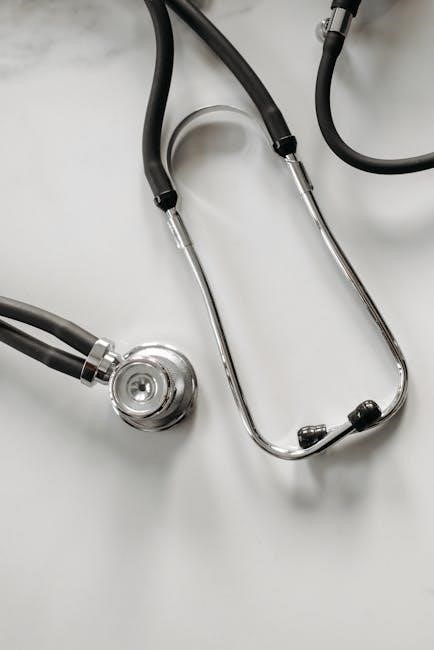
clinical medicine for physician assistants pdf
Clinical medicine is central to Physician Assistants, involving evidence-based care and diagnostics. A guide covers essential topics for effective practice.
1.1 The Role of Physician Assistants in Clinical Medicine
Physician Assistants (PAs) play a pivotal role in clinical medicine, serving as essential healthcare providers. They diagnose and treat illnesses, conduct physical exams, order diagnostic tests, interpret results, and develop treatment plans. PAs work collaboratively with physicians and other healthcare professionals to deliver high-quality patient care. They are trained to practice in various medical settings, including primary care, emergency medicine, and specialty fields. Their responsibilities encompass patient education, preventive care, and managing chronic conditions. PAs are integral to improving healthcare access and efficiency, ensuring comprehensive and evidence-based care. This role underscores the importance of PAs in addressing the growing demands of the healthcare system while maintaining the highest standards of patient outcomes.
1.2 Importance of Evidence-Based Practice in PA Education
Evidence-based practice (EBP) is crucial in PA education, guiding PAs to make informed decisions using current scientific research and clinical data. EBP ensures that care is safe, effective, and tailored to patient needs. By integrating best practices, PAs stay updated on the latest advancements, improving patient outcomes and reducing medical errors. Educational programs emphasize EBP to equip PAs with critical thinking skills, enabling them to evaluate evidence and apply it in diverse clinical settings. This approach fosters a culture of lifelong learning, preparing PAs to adapt to evolving healthcare challenges and deliver high-quality care.

Core Concepts in Clinical Medicine
Clinical medicine’s core includes anatomy, physiology, and pathophysiology, forming the foundation for understanding diseases and treatments. These concepts guide diagnosis and management, ensuring effective patient care.
2.1 Anatomy, Physiology, and Pathophysiology
Anatomy, physiology, and pathophysiology are foundational to clinical medicine, enabling PAs to understand body structures, functions, and disease mechanisms. These concepts guide diagnostic reasoning and treatment decisions. Anatomy explores body systems, while physiology explains their functions. Pathophysiology examines how diseases disrupt normal processes, aiding in identifying symptoms and underlying causes. Together, these disciplines provide a framework for evaluating patients and developing evidence-based care plans. Textbooks like Physician Assistant: A Guide to Clinical Practice emphasize these principles, ensuring PAs grasp the interplay between structure and function. Mastery of these areas is crucial for accurate diagnoses and effective patient management in various clinical settings, from primary care to specialized medicine.
2.2 Medical Sciences and Clinical Correlations
Medical sciences form the backbone of clinical practice, integrating microbiology, pharmacology, and pathology to guide patient care. Clinical correlations link scientific knowledge to real-world patient scenarios, enabling PAs to interpret symptoms, order diagnostics, and develop targeted therapies. Textbooks like Physician Assistant: A Guide to Clinical Practice emphasize these connections, ensuring PAs can apply evidence-based principles. Understanding disease mechanisms and treatment options is vital for accurate diagnoses and effective management. This knowledge is also central to certification exams, such as the NCCPA, which assesses PAs’ ability to apply medical sciences in clinical settings. Mastery of these correlations ensures PAs provide high-quality, patient-centered care across diverse medical specialties.

Diagnostic and Treatment Approaches
Common presentations in emergency medicine, such as chest pain and abdominal pain, require timely diagnostics and evidence-based treatments, ensuring effective patient care and outcomes.
3.1 Common Presentations in Emergency Medicine
In emergency medicine, Physician Assistants frequently encounter common presentations such as chest pain, abdominal pain, altered mental status, and traumatic injuries. These conditions require rapid assessment and evidence-based decision-making to ensure timely interventions. For instance, chest pain may indicate cardiac issues like myocardial infarction, while abdominal pain could signal appendicitis or gastrointestinal disorders. Altered mental status often points to neurological or metabolic disturbances, necessitating thorough diagnostic workups. Traumatic injuries, such as fractures or head trauma, demand immediate stabilization and management. PAs must integrate patient history, physical examination findings, and diagnostic testing to prioritize care effectively. These scenarios highlight the critical role of PAs in emergency settings, where accurate diagnoses and prompt treatments are essential for improving patient outcomes.
- Chest pain
- Abdominal pain
- Altered mental status
- Traumatic injuries
3;2 Diagnostic Testing and Interpretation
Diagnostic testing is a cornerstone of clinical medicine, enabling Physician Assistants to confirm diagnoses and guide treatment. Common tests include imaging, lab work, and EKGs. Accurate interpretation of these results is crucial for effective patient care. For example, abnormal troponin levels may indicate myocardial infarction, while imaging can reveal fractures or organ damage; PAs must integrate test results with clinical presentations to formulate evidence-based plans. Proper interpretation prevents misdiagnoses and ensures timely interventions, improving patient outcomes. Staying updated on testing guidelines and advancements is essential for PAs to deliver high-quality care.
- Imaging studies
- Laboratory tests
- Electrocardiograms (EKGs)
3.3 Pharmacotherapy and Treatment Guidelines
Pharmacotherapy is a critical component of clinical medicine, requiring Physician Assistants to apply evidence-based treatment guidelines. PAs must stay updated on the latest medication therapies and algorithms to ensure optimal patient outcomes. This includes understanding drug mechanisms, dosages, and potential interactions. Treatment guidelines often vary by condition, such as hypertension or diabetes, and PAs must tailor therapies to individual patient needs. Adherence to established protocols minimizes risks and improves efficacy. Continuous education on pharmacological advancements and clinical practice guidelines is essential for PAs to provide safe and effective care.
- Evidence-based treatment algorithms
- Medication dosing and interactions
- Condition-specific guidelines

Patient Assessment and Management
Patient assessment involves evaluating symptoms, medical history, and physical findings to diagnose and manage conditions effectively. PAs use evidence-based guidelines to develop personalized treatment plans.
4.1 History Taking and Physical Examination
History taking and physical examination are foundational skills for Physician Assistants, enabling accurate diagnoses and effective patient care. A thorough medical history includes chief complaints, past medical history, medications, and lifestyle factors. Physical exams involve systematic assessment of vital signs, organ systems, and symptoms. Evidence-based guidelines guide PAs in identifying abnormal findings and correlating them with potential diagnoses; These skills are essential for developing targeted treatment plans and ensuring comprehensive patient management. Proficiency in history taking and physical examination is critical for PAs to deliver high-quality, patient-centered care in diverse clinical settings. Online resources and textbooks provide detailed algorithms and case studies to refine these competencies, ensuring PAs stay current with best practices in clinical medicine.
4.2 Patient Education and Health Promotion
Patient education and health promotion are integral to the Physician Assistant’s role, fostering empowerment and better health outcomes. PAs educate patients on disease prevention, management, and lifestyle modifications, ensuring they understand their conditions and treatments. Health promotion involves encouraging healthy behaviors, such as regular screenings, vaccination, and nutrition counseling. Effective communication and cultural sensitivity are key to making education accessible and impactful. PAs also address health disparities by tailoring education to individual needs. Resources like guidelines and online platforms support PAs in delivering evidence-based education. By prioritizing patient education, PAs help patients take an active role in their care, improving long-term health and reducing complications. This approach aligns with the broader goals of preventive care and population health.

Specialized Areas of Clinical Medicine
Specialized areas include infectious diseases, cardiovascular disorders, and gastrointestinal conditions, focusing on diagnosis, treatment, and management to provide comprehensive patient care.
5.1 Infectious Diseases and Antibiotic Use
Infectious diseases are a critical area of clinical medicine, requiring PAs to understand pathogenesis, diagnosis, and treatment. Antibiotic stewardship is essential to combat resistance. Common infections like pneumonia, urinary tract infections, and skin infections are frequently encountered. PAs must differentiate between bacterial, viral, and fungal etiologies to guide appropriate therapy. Guidelines emphasize evidence-based prescribing to minimize misuse. For example, beta-lactams are first-line for many bacterial infections, while antivirals are reserved for specific viral pathogens. Patient history, labs, and imaging aid in accurate diagnosis. Resistance patterns and local epidemiology inform treatment choices. PAs play a vital role in educating patients about infection prevention and proper antibiotic use to ensure safe and effective care.
5.2 Cardiovascular and Respiratory Disorders
Cardiovascular and respiratory disorders are common and critical areas in clinical medicine. Physician Assistants must assess symptoms like chest pain, dyspnea, and cough. Diagnostics include ECGs, chest X-rays, and spirometry. Conditions such as hypertension, heart failure, and COPD require tailored management. Pharmacotherapy includes ACE inhibitors, beta-blockers, and bronchodilators. Lifestyle modifications, like smoking cessation, are crucial. PAs play a key role in educating patients and managing chronic diseases effectively.
5.3 Gastrointestinal and Genitourinary Conditions
Gastrointestinal and genitourinary conditions are prevalent in clinical practice, requiring PAs to diagnose and manage accurately. Common GI disorders include GERD, peptic ulcers, IBD, and diverticulitis. Genitourinary issues often involve UTIs, kidney stones, and prostate conditions. Diagnostic tools such as endoscopy, colonoscopy, urinalysis, and imaging are essential. Treatment options include pharmacotherapy like PPIs, antibiotics, and antispasmodics, alongside surgical interventions for severe cases. Patient education on diet, hydration, and lifestyle modifications is crucial for long-term management. PAs play a vital role in improving outcomes through early detection and evidence-based care.

Emergency Medicine and Critical Care
Emergency medicine and critical care involve acute patient stabilization, trauma management, and life-saving interventions. PAs must master rapid assessment, decision-making, and evidence-based protocols to ensure optimal outcomes.

6.1 Traumatic Injuries and Acute Care
Traumatic injuries require prompt and precise management to ensure patient survival and optimal recovery. Physician Assistants play a critical role in assessing and stabilizing patients with acute injuries. Common presentations include head trauma, fractures, and chest injuries, necessitating a systematic approach. The primary survey, following the ATLS (Advanced Trauma Life Support) protocol, focuses on airway, breathing, circulation, and neurological assessment. Diagnostic imaging, such as CT scans and X-rays, aids in identifying the extent of injuries. Management strategies include splinting, wound care, and pain control. PAs must also address complications like hemorrhage and shock, ensuring timely interventions. Evidence-based guidelines and continuous training are essential for providing high-quality acute care in trauma settings.
6.2 Emergency Algorithms and Decision-Making
Emergency algorithms and decision-making are critical in acute care, guiding Physician Assistants (PAs) to assess and manage patients effectively. These structured protocols, such as ATLS and ACLS, ensure standardized approaches to common emergencies. PAs must quickly identify life-threatening conditions, prioritize interventions, and implement evidence-based treatments. Real-world case studies and practical algorithms enhance decision-making skills, enabling PAs to navigate complex scenarios confidently. Diagnostic testing and treatment plans are tailored to patient needs, ensuring timely and appropriate care. Staying updated with the latest guidelines and engaging in interactive learning tools further refine these skills, allowing PAs to deliver high-quality emergency care and improve patient outcomes in dynamic clinical settings.

Professional Development and Certification
Physician Assistants must pursue continuous learning and certification through exams like the NCCPA to maintain expertise and stay updated on clinical practices and guidelines.
7.1 Certification Exam Preparation (NCCPA)
Preparation for the NCCPA certification exam is crucial for Physician Assistants to demonstrate competence in clinical medicine. The exam covers anatomy, physiology, microbiology, pathology, and medical sciences. Candidates must focus on evidence-based practice, diagnostic testing, and treatment guidelines. Utilizing textbooks like Physician Assistant: A Guide to Clinical Practice and online resources ensures comprehensive review. Practice exams and case studies help assess readiness. The exam blueprint aligns with clinical medicine courses, emphasizing patient presentations and management. Continuous learning and professional growth are essential for success. This section provides strategies and resources for effective exam preparation, ensuring PAs are well-prepared to meet certification standards.
7.2 Continuing Medical Education (CME) Requirements
Continuing Medical Education (CME) is vital for Physician Assistants to stay updated on medical advancements and guidelines. CME requirements ensure PAs maintain certification and clinical competency. Various formats, including online courses, workshops, and conferences, provide flexible learning opportunities. Topics often cover evidence-based practices, diagnostic techniques, and emerging therapies. Many resources, such as Physician Assistant: A Guide to Clinical Practice, offer CME credits. PAs must complete a certain number of hours annually to meet professional standards. This commitment fosters continuous learning and adaptation to evolving healthcare needs, ensuring high-quality patient care and professional growth. Staying informed through CME is essential for PAs to remain effective and current in their practice.

Legal and Ethical Considerations
Legal and ethical considerations are crucial for Physician Assistants, ensuring compliance with medical laws, ethical dilemmas, and professional responsibilities. Understanding these principles is essential for safe, respectful practice.
8.1 Medical Liability and Risk Management
Medical liability and risk management are critical for Physician Assistants (PAs) to minimize legal exposure. Understanding state-specific regulations and employer guidelines helps mitigate risks. Proper documentation, adherence to evidence-based practices, and clear communication with patients and supervisors are essential. Staying informed about professional standards and maintaining continuous education can reduce malpractice claims. Additionally, PAs should be aware of their scope of practice and collaborative agreements to avoid overstepping boundaries. Regular reviews of patient care and adherence to ethical guidelines further safeguard against legal issues. Implementing these strategies ensures a safer practice environment for both patients and healthcare providers.
8.2 Ethical Dilemmas in Clinical Practice
Ethical dilemmas are common in clinical practice, requiring Physician Assistants (PAs) to balance patient autonomy, beneficence, and justice. Challenges may arise in end-of-life care, confidentiality, and resource allocation. PAs must navigate these issues with empathy and adherence to professional ethics. Staying informed about ethical guidelines and seeking mentorship can aid decision-making. Open communication with patients and interdisciplinary teams is crucial. Addressing these dilemmas fosters trust and upholds the integrity of healthcare delivery, ensuring PAs provide compassionate and ethical care in all situations.

Resources and References
Comprehensive textbooks like Physician Assistant: A Guide to Clinical Practice and online platforms provide essential resources for PAs, including evidence-based guidelines and interactive learning tools.
9.1 Recommended Textbooks and Guidelines
Several textbooks are highly recommended for Physician Assistant (PA) students, including Physician Assistant: A Guide to Clinical Practice, now in its 6th edition. This comprehensive guide covers all aspects of clinical medicine, from foundational sciences to practical patient care. Another key resource is Clinical Medicine for Physician Assistants, designed specifically for PA education. These texts align with certification exam blueprints and provide evidence-based practice guidelines. Additionally, Physician Assistant: Clinical Medicine offers detailed insights into diagnostics and treatment. These resources are complemented by online platforms and evidence-based guidelines from organizations like the CDC and WHO, ensuring PAs stay updated on best practices and protocols. These materials are indispensable for both education and clinical practice, supporting PAs in delivering high-quality patient care.
9.2 Online Platforms for PA Education
Online platforms play a vital role in PA education, offering accessible resources for clinical medicine. Websites like PhysicianAssistantEDU and PAEA provide comprehensive learning materials, including downloadable PDF guides, case studies, and interactive tools. These platforms often feature evidence-based practice guidelines, diagnostic algorithms, and treatment protocols. Additionally, professional organizations such as the Society of Emergency Medicine Physician Assistants offer updated best-practice guidelines and continuing education opportunities. Online forums and communities, like those on Reddit or specialized PA groups, foster collaboration and knowledge sharing. Many platforms also offer NCCPA exam prep materials, ensuring PAs stay current with certification requirements. These digital resources are essential for both students and practicing PAs, promoting lifelong learning and professional development in clinical medicine.
Clinical medicine for PAs integrates knowledge, skills, and continuous learning, ensuring effective patient care and professional growth in a dynamic healthcare landscape.
10.1 The Future of Physician Assistant Practice
The future of Physician Assistant practice is poised for growth, driven by increasing demand for healthcare services and workforce shortages. The role of PAs is expanding, with greater integration of technology and evidence-based practices. There is a growing emphasis on lifelong learning and professional development to meet evolving patient needs. Certification and continuing education will remain critical, ensuring PAs stay current with medical advancements. Additionally, policy reforms and advocacy efforts aim to enhance PA autonomy and scope of practice. As healthcare systems evolve, PAs will play a vital role in delivering high-quality, patient-centered care, making their profession indispensable in modern medicine.
10.2 Continuous Learning and Professional Growth
Continuous learning and professional growth are essential for Physician Assistants to stay current with medical advancements and deliver high-quality care. PAs must engage in lifelong learning to maintain certification and adapt to evolving healthcare demands. The National Commission on Certification of Physician Assistants (NCCPA) requires ongoing education and recertification to ensure competence. Professional growth involves staying updated on evidence-based practices, diagnostic techniques, and treatment guidelines. PAs can access various resources, including textbooks, online platforms, and professional organizations, to support their development. By prioritizing continuous learning, PAs enhance their ability to provide effective patient care and remain leaders in clinical medicine.